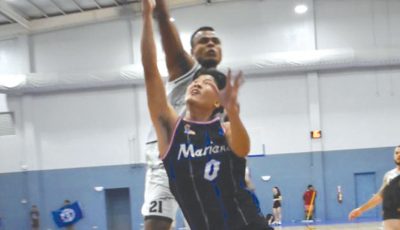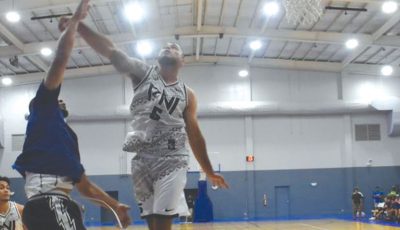Frank Rosario: A well-rounded life
Editor’s Note: This article was originally published in the January-March 2012 edition of TAGA Sports. It is being reprinted here in honor of Frank Rosario, who passed away yesterday.
Trying to put a finger on the place of Frank S. Rosario in Northern Marianas sports history is like tracing the path of Kobe Bryant doing a 360-degree slamdunk…a complete circle that few can match: athlete, writer, organizing executive, and fan.
A good place to begin is 1969. As the moniker “Super Bowl” was first being used in American football, half a world away tiny islands of the Pacific were launching their first regional games, the “Micronesia Olympics.”
Rosario was fresh out of high school and newly recruited to play on the Northern Marianas national basketball team for the games. Unfortunately, the forces of nature were working against the home team that year. In 1967, a typhoon had knocked out all island power and had destroyed all sports facilities on island, except for basketball courts. Due to the devastation of the storm, organized sports had also been knocked off its feet.
“For one year we hadn’t had games,” Rosario recalls. “Then in 1969, prior to the start of the games, they were running around recruiting players like out-of-shape Frank. They recruited well-known athletes, swimmers, and track and field. We had baseball players, basketball players, volleyball players…they selected what they called the ‘all-stars’ to be part of the national team.”
At 5’9” and 200 pounds, Rosario was a starter, playing both center and guard. Along with his teammates—he calls some of them to mind: Ignacio Demapan, Diego Blanco, David Aldan, George Camacho—the basketball team opened up the Micronesian Olympics with the inaugural game, facing off against Palau.
“I like guard. That’s what I’m used to, and I can shoot a jumpshot pretty well from a distance,” says Rosario. “At the time I was playing, there was no three-point line. Some of the points that I scored were definitely three pointers.”
Nonetheless, the team struggled and finished third.
“I was proud to represent the Northern Marianas, but we were not a well-conditioned team,” Rosario offers candidly.
Despite a lackluster athletic performance, his first games still hold vivid memories for Rosario.
“The basefield field was good. Not as good as today, but very modest. The lone basketball court was outdoor in Susupe at the former Civic Center. There were no women’s basketball games, because basketball was just starting. Volleyball was held outside the Chalan Kanoa Elementary School auditorium on a grass court.
“The track and field was pressed gravel. Our swimming pool was up at Garapan Fishing Base. They put ropes to divide the lanes where the boat ramp is today. It was very deep. I wonder what would’ve happened if it had been a windy day and seas were rough…”
Rosario’s favorite recollection of the Games was a competitor from Pohnpei who drew quite a crowd and who was also the likely cause of Saipan’s first traffic jam; both stirred up quite a buzz in the community.
“There was a guy from Pohnpei, Ishiro Hairens. He won four gold medals, all in track and field: 1,500 meters, 3,000 meters, 5,000 meters, 10,000 meters. He beat everybody as if those guys were not even in the race, I mean, he beat them badly,” Rosario recalls.
“He became a crowd favorite. When he went for the 10,000 meters, they had to run all the way up from (the current Ada Gymnasium) to Garapan Fishing Base and back. He came in smoking, a cigarette dangling from his lips. It was just for show. That got the crowd going. Not only that, after running, like…” Rosario gestures to show the long distance, “…someone like me would’ve been dead from exhaustion, but this guy was making fun out of it! He would wait for [the last] 100 meters, then take off as fast as he could. Unbelievable. Barefoot, eh?
“Because of his accomplishments in the games, Pohnpei took him and entered him in a race in Japan, but he quit because it was too cold. And also, he was forced to wear shoes. I met him again in 1982. I wonder where he is now…”
Despite being an active player in high school and medaling in the Micronesian Olympics, it was only a few years later that Rosario hung up his jersey.
“The last time I played organized basketball was in 1972, when Papua New Guinea came with their naval ship, and they challenged a team from Saipan. Somebody called us up and asked us to play, and we got creamed. We lost badly, again, because there was no organized basketball.”
It was about that time that Rosario began honing new skills for the next phase of his career: word play. He was working as an assistant public information officer for the Trust Territory government when the time came for the second Micronesian Games.
“I was sitting in the chambers covering the Congress of Micronesia when that conversation came up. The games were supposed to come every three years, but Congress did not appropriate money for the second games in Palau, so the games were dead.”
In 1973 he was sent by the TT public information office to Fort Benjamin Harrison in Indianapolis, Indiana, for U.S. Defense Information School, a 10-week journalism course.
“I was the only Chamorro in the public information office, and I was sent to school to improve my English. I was the only civilian there; my classmates were Air Force, Marines, Army, Navy. Everyone came in with a uniform, and I walked in with my Hawaiian print shirt.“
During his TT tenure, Rosario contributed on “everything under the sun” to the monthly Micronesian Reporter, and went on to become bureau chief of the government-owned Micronesian News Service, the only region-wide news service of the time. During this time he also covered Micronesia’s first participation in the South Pacific Games (SPG) in Guam in 1975, simultaneously serving as public information officer for the Micronesia-wide Executive Committee of the SPG.
From his early beginning in with the TT government, Rosario’s career then lead him to the positions of managing editor of the former Commonwealth Examiner and as the Saipan bureau chief for the Pacific Daily News.
With the formation of the young Commonwealth of the Northern Mariana Islands, Rosario transitioned back to public service, serving on the Cabinet of three governors: press secretary and protocol officer for Gov. Lorenzo I. Guerrero and Gov. Pedro P. Tenorio, and special assistant for Micronesian affairs for Gov. Juan N. Babauta.
He was perfectly positioned to help advocate for the revival of the games in 1990. By then, the games had a new name.
“Somebody from the World Olympics wrote and told us not to use the word ‘Olympics,’” he recalls. “It’s like ‘U.S. Congress.’ People were of the opinion that we could call the local legislature, the ‘Congress.’ But there’s only one Congress, and there’s only one Olympics.”
“Bill Sakovich, Kurt Banes, Mike White, [and] Bob Coldeen started discussing the second games. I told them, ‘Go and find out if they’re interested, and I’ll ask Governor Guerrero to support it.’ Bill went around to all the Micronesian districts at the time, and asked the leaders if they would support the Micronesia Games.”
The Micronesian Games returned in 1990, with Rosario again taking on the role of public information officer of the executive committee. Sixteen years later, he also helped advocate for the return of the Games to the Northern Mariana Islands in 2006, after private sector financial pledges convinced the cash-strapped government to proceed with hosting the event.
“[Frank] was an above-average basketball player,” recalls Kurt Banes, a key organizer of the first Micronesian Olympics and a constant figure throughout subsequent Games and Northern Marianas sports. “Frank was a stanch sports supporter. He understood the complexities of all sports. He attended every track meet that was held on the all-weather track at the Ada Gym and understood what good times and marks were.”
Finally, after 26 years of government service, Rosario retired from public service in 2006.
Following a short stint as a correspondent for Pacific Magazine, he now finds time to enjoy wearing yet another hat, sports fan. From one season to the next, he closely follows the Los Angeles Dodgers, New England Patriots, and Los Angeles Lakers.
“I’m very bothered that the National Basketball Association has missed the starting of the games because of the labor dispute,” he says. “I’m very disappointed.”
These days Rosario spends most of his days in the coolness of his back porch, welcoming old friends and visitors for a trip down memory lane or a debate on today’s newspaper headlines. His memory still sharp, he continues to be a wellspring of both official and behind-the-scenes history and a master storyteller of his own well-rounded life, including time spent hitting shots on the court, crafting the story on the newsbeat, planning for all possible contingencies involving hundreds of athletes in the meeting room, and watching the world go by from the comfort of his armchair.



























